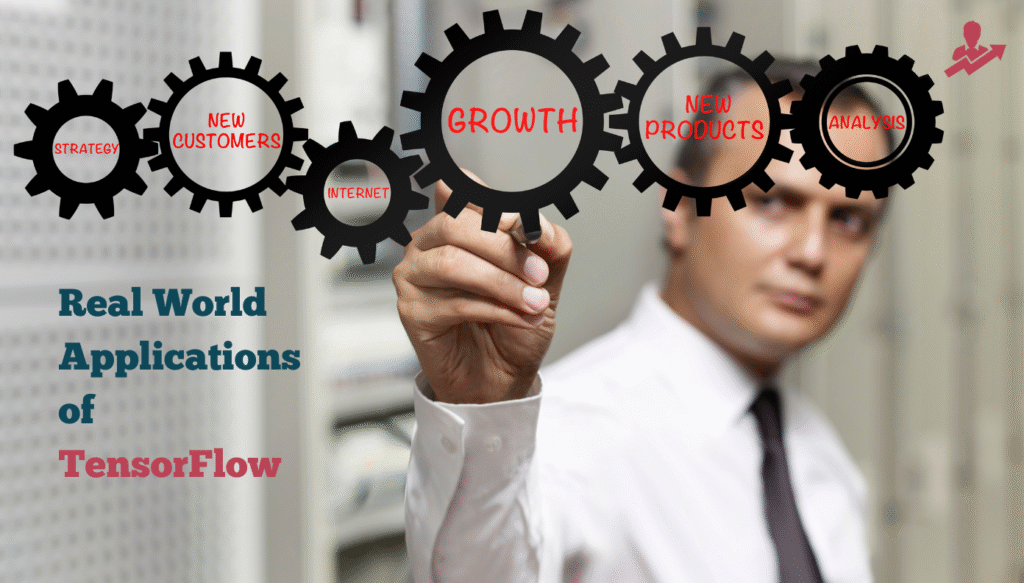Real World Applications of TensorFlow: How TensorFlow Is Used

Explore real-world applications of TensorFlow in this beginner’s guide. Learn how TensorFlow is used in healthcare, finance, image recognition, voice assistants, and more in a simple and easy-to-understand way.
Introduction
Now that you’ve learned what TensorFlow is, how to install it, and even how to build your first neural network, you might be wondering: Where is TensorFlow actually used in real life? The answer is everywhere.
From the apps you use daily to advanced scientific research, TensorFlow plays a huge role in making smarter systems. In this blog, I’ll walk you through some of the most popular real-world applications of TensorFlow. We’ll keep it simple and clear, so even if you’re not technical, you’ll see how TensorFlow is shaping the world around you.
1. Healthcare: Helping Doctors Make Smarter Decisions
One of the most amazing places TensorFlow is used is healthcare. With TensorFlow, AI systems can help doctors analyze medical images like X-rays or MRIs to detect diseases such as cancer earlier and more accurately.
Hospitals use machine learning models to predict patient outcomes, recommend treatments, and even track patient health remotely using wearable devices. TensorFlow’s ability to handle large datasets and find patterns helps make healthcare faster and more reliable, saving lives in the process.
2. Finance: Predicting Trends and Detecting Fraud
In finance, TensorFlow helps analyze huge amounts of data to spot trends, predict stock prices, and prevent fraud. Banks and investment companies use TensorFlow models to automate decisions and monitor suspicious activity in real time.
For example, credit card companies use TensorFlow-powered systems to detect unusual transactions and block fraudulent charges before they happen. It’s like having an invisible security guard that watches every transaction instantly and keeps you safe.
3. Image and Speech Recognition: Powering Smart Apps
TensorFlow is behind many of the smart apps you use every day, especially those that involve recognizing images or understanding speech.
Apps like Google Photos automatically tag faces or objects using TensorFlow models, while voice assistants like Siri and Google Assistant understand your commands and reply instantly. These systems are trained on millions of images and voice samples, helping them become more accurate and helpful with each use.
4. Self-Driving Cars: Teaching Vehicles to Navigate Roads
Self-driving cars are another exciting area where TensorFlow is making a huge impact. These cars need to “see” and understand their environment in real time, recognizing pedestrians, street signs, and obstacles to navigate safely.
TensorFlow helps train models to process video feeds from cameras and sensors, identify patterns, and make decisions quickly. With TensorFlow, autonomous driving systems are learning to improve continuously, making roads safer for everyone.
5. Personalized Recommendations: Making Apps Smarter
Have you ever wondered how streaming services like Netflix or YouTube recommend shows you might like? TensorFlow helps by analyzing your watching history and comparing it with millions of other users.
The models learn what kinds of content you prefer and suggest new videos, songs, or products tailored to your interests. This personalized experience keeps users engaged and makes platforms smarter with every interaction.
6. Agriculture: Improving Crop Yields
TensorFlow is also helping farmers make better decisions by analyzing data from satellites, sensors, and weather forecasts. AI models can predict soil health, crop diseases, and irrigation needs, helping farmers improve yields and reduce waste.
By using TensorFlow, agricultural experts can monitor fields in real time, making farming more sustainable and efficient, which is especially important as the world faces climate challenges.
7. Education: Helping Students Learn Smarter
Education platforms are using TensorFlow to create adaptive learning systems that adjust lessons based on a student’s performance. If a student struggles with a concept, the system can recommend extra practice or offer simpler explanations.
This personalized approach helps students learn at their own pace, making education more accessible and enjoyable for everyone. TensorFlow-powered tools are now helping teachers provide better support and track progress more effectively.
Final Thoughts
TensorFlow is everywhere — in healthcare, finance, transportation, agriculture, and education. It’s helping businesses and individuals make smarter decisions, save time, and improve lives.
You don’t need to be an expert to understand its power. By learning how TensorFlow works and how it’s applied in real life, you’re one step closer to building your own projects or exploring exciting career paths in AI and machine learning.
FAQ’s
Q1. Is TensorFlow only used by big tech companies?
No, TensorFlow is used by startups, research labs, and even schools. Big tech companies like Google or Netflix are well known for using it, but smaller businesses and educational platforms also use TensorFlow to solve real-world problems. It’s open-source, which makes it accessible to everyone.
Q2. Can TensorFlow really help in healthcare?
Absolutely. TensorFlow is a tool for analyzing medical imagery, predicting diseases, and monitoring patient health. AI models trained on large datasets can help doctors diagnose conditions faster and more accurately, which ultimately improves patient care and saves lives.
Q3. How does TensorFlow help in finance?
TensorFlow helps banks and financial institutions process huge amounts of data quickly. It’s used for predicting market trends, detecting fraudulent transactions, and automating decision-making. These models help protect users and manage risks more effectively.
Q4. Can TensorFlow be used on smartphones and smaller devices?
Yes, TensorFlow Lite is optimized for mobile phones, wearables, and tiny hardware devices. It helps run AI models efficiently without using too much memory or battery, enabling smart features like voice assistants and image recognition on the go.
Q5. Is it difficult to start building real-world projects with TensorFlow?
Not at all. With tools like Keras and pre-trained models, beginners can start by experimenting with small projects. You can practice with datasets, try image or speech recognition tasks, and gradually work your way toward more complex applications as you learn.
